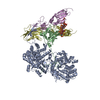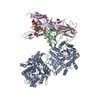+Search query
-Structure paper
| Title | Structural basis for FGF hormone signalling. |
|---|---|
| Journal, issue, pages | Nature, Vol. 618, Issue 7966, Page 862-870, Year 2023 |
| Publish date | Jun 7, 2023 |
 Authors Authors | Lingfeng Chen / Lili Fu / Jingchuan Sun / Zhiqiang Huang / Mingzhen Fang / Allen Zinkle / Xin Liu / Junliang Lu / Zixiang Pan / Yang Wang / Guang Liang / Xiaokun Li / Gaozhi Chen / Moosa Mohammadi /   |
| PubMed Abstract | α/βKlotho coreceptors simultaneously engage fibroblast growth factor (FGF) hormones (FGF19, FGF21 and FGF23) and their cognate cell-surface FGF receptors (FGFR1-4) thereby stabilizing the endocrine ...α/βKlotho coreceptors simultaneously engage fibroblast growth factor (FGF) hormones (FGF19, FGF21 and FGF23) and their cognate cell-surface FGF receptors (FGFR1-4) thereby stabilizing the endocrine FGF-FGFR complex. However, these hormones still require heparan sulfate (HS) proteoglycan as an additional coreceptor to induce FGFR dimerization/activation and hence elicit their essential metabolic activities. To reveal the molecular mechanism underpinning the coreceptor role of HS, we solved cryo-electron microscopy structures of three distinct 1:2:1:1 FGF23-FGFR-αKlotho-HS quaternary complexes featuring the 'c' splice isoforms of FGFR1 (FGFR1c), FGFR3 (FGFR3c) or FGFR4 as the receptor component. These structures, supported by cell-based receptor complementation and heterodimerization experiments, reveal that a single HS chain enables FGF23 and its primary FGFR within a 1:1:1 FGF23-FGFR-αKlotho ternary complex to jointly recruit a lone secondary FGFR molecule leading to asymmetric receptor dimerization and activation. However, αKlotho does not directly participate in recruiting the secondary receptor/dimerization. We also show that the asymmetric mode of receptor dimerization is applicable to paracrine FGFs that signal solely in an HS-dependent fashion. Our structural and biochemical data overturn the current symmetric FGFR dimerization paradigm and provide blueprints for rational discovery of modulators of FGF signalling as therapeutics for human metabolic diseases and cancer. |
 External links External links |  Nature / Nature /  PubMed:37286607 / PubMed:37286607 /  PubMed Central PubMed Central |
| Methods | EM (single particle) |
| Resolution | 2.74 - 3.2 Å |
| Structure data | EMDB-34075, PDB-7ysh: EMDB-34082, PDB-7ysu: EMDB-34084, PDB-7ysw: |
| Chemicals |  ChemComp-ZN:  ChemComp-CU: |
| Source |
|
 Keywords Keywords | SIGNALING PROTEIN / FGF hormones / FGF Receptor / Klotho Co-Receptor / Heparan Sulfate Glycosaminoglycans |
 Movie
Movie Controller
Controller Structure viewers
Structure viewers About Yorodumi Papers
About Yorodumi Papers









 homo sapiens (human)
homo sapiens (human)